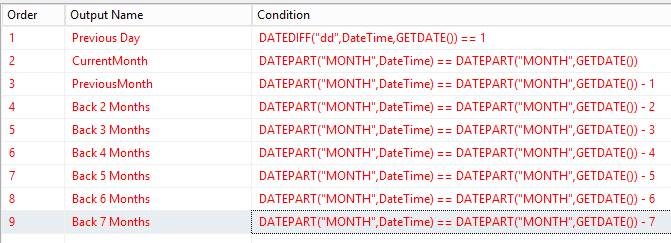SSIS – Getting Partition Names for the past 12 months
I had a situation where I was using a conditional split, so that when data was coming in from my source tables it would dynamically go into the correct partitioned table.
Below is the script that I used, as well as for reference the conditional split
— ==================================================================================================================
— What we are doing here is to create a Proc so that we can get the PartitionNames going back 12 months.
— While for the first time this is a manual process this can be used for other Parition Schemes going foward.
— The only thing that will need to change if the Partition Naming convention is the same is the Partition name
— ==================================================================================================================
— ==================================================================================================================
— 1. Here we are getting our current partition naming scheme into a variable.
— Example of partition scheme: Mart_TF_InternetSales_2014_02
— ==================================================================================================================
Declare@PartitionNameasvarchar(30)
Set@PartitionName=
(
Select‘Mart_TF_InternetSales_’
)
— ==================================================================================================================
— 2. Here we are getting our Current Month Details.
— NOTE: We are using our Date Dimension to get our Year and Month, we are then replacing the dash “-” with an
— underscore “_” as per our Parition Naming Scheme.
— ==================================================================================================================
Declare@CurrentMonthNameasvarchar(8)
Set@CurrentMonthName=
(
SelectReplace(YearMonth,‘-‘,‘_’)
fromMart_TD_Datewith (nolock)
whereFullDate=convert(date,dateadd(ms,+0,DATEADD(mm,DATEDIFF(m,0,getdate() )-0, 0)))
)
— ==================================================================================================================
— 3. Here we are getting our 1 Month Back.
— NOTE: We are using our Date Dimension to get our Year and Month, we are then replacing the dash “-” with an
— underscore “_” as per our Parition Naming Scheme.
— ==================================================================================================================
Declare@OneMonthBackasvarchar(8)
Set@OneMonthBack=
(
SelectReplace(YearMonth,‘-‘,‘_’)
fromMart_TD_Datewith (nolock)
whereFullDate=convert(date,dateadd(ms,+0,DATEADD(mm,DATEDIFF(m,0,getdate() )-1, 0)))
)
— ==================================================================================================================
— 4. Here we are getting our 2 Month Back.
— NOTE: We are using our Date Dimension to get our Year and Month, we are then replacing the dash “-” with an
— underscore “_” as per our Parition Naming Scheme.
— ==================================================================================================================
Declare@TwoMonthBackasvarchar(8)
Set@TwoMonthBack=
(
SelectReplace(YearMonth,‘-‘,‘_’)
fromMart_TD_Datewith (nolock)
whereFullDate=convert(date,dateadd(ms,+0,DATEADD(mm,DATEDIFF(m,0,getdate() )-2, 0)))
)
— ==================================================================================================================
— 4. Here we are getting our 3 Month Back.
— NOTE: We are using our Date Dimension to get our Year and Month, we are then replacing the dash “-” with an
— underscore “_” as per our Parition Naming Scheme.
— ==================================================================================================================
Declare@ThreeMonthBackasvarchar(8)
Set@ThreeMonthBack=
(
SelectReplace(YearMonth,‘-‘,‘_’)
fromMart_TD_Datewith (nolock)
whereFullDate=convert(date,dateadd(ms,+0,DATEADD(mm,DATEDIFF(m,0,getdate() )-3, 0)))
)
— ==================================================================================================================
— 4. Here we are getting our 4 Month Back.
— NOTE: We are using our Date Dimension to get our Year and Month, we are then replacing the dash “-” with an
— underscore “_” as per our Parition Naming Scheme.
— ==================================================================================================================
Declare@FourMonthBackasvarchar(8)
Set@FourMonthBack=
(
SelectReplace(YearMonth,‘-‘,‘_’)
fromMart_TD_Datewith (nolock)
whereFullDate=convert(date,dateadd(ms,+0,DATEADD(mm,DATEDIFF(m,0,getdate() )-4, 0)))
)
— ==================================================================================================================
— 4. Here we are getting our 5 Month Back.
— NOTE: We are using our Date Dimension to get our Year and Month, we are then replacing the dash “-” with an
— underscore “_” as per our Parition Naming Scheme.
— ==================================================================================================================
Declare@FiveMonthBackasvarchar(8)
Set@FiveMonthBack=
(
SelectReplace(YearMonth,‘-‘,‘_’)
fromMart_TD_Datewith (nolock)
whereFullDate=convert(date,dateadd(ms,+0,DATEADD(mm,DATEDIFF(m,0,getdate() )-5, 0)))
)
— ==================================================================================================================
— 4. Here we are getting our 6 Month Back.
— NOTE: We are using our Date Dimension to get our Year and Month, we are then replacing the dash “-” with an
— underscore “_” as per our Parition Naming Scheme.
— ==================================================================================================================
Declare@SixMonthBackasvarchar(8)
Set@SixMonthBack=
(
SelectReplace(YearMonth,‘-‘,‘_’)
fromMart_TD_Datewith (nolock)
whereFullDate=convert(date,dateadd(ms,+0,DATEADD(mm,DATEDIFF(m,0,getdate() )-6, 0)))
)
— ==================================================================================================================
— 4. Here we are getting our 7 Month Back.
— NOTE: We are using our Date Dimension to get our Year and Month, we are then replacing the dash “-” with an
— underscore “_” as per our Parition Naming Scheme.
— ==================================================================================================================
Declare@SevenMonthBackasvarchar(8)
Set@SevenMonthBack=
(
SelectReplace(YearMonth,‘-‘,‘_’)
fromMart_TD_Datewith (nolock)
whereFullDate=convert(date,dateadd(ms,+0,DATEADD(mm,DATEDIFF(m,0,getdate() )-7, 0)))
)
— ==================================================================================================================
— 4. Here we are getting our 8 Month Back.
— NOTE: We are using our Date Dimension to get our Year and Month, we are then replacing the dash “-” with an
— underscore “_” as per our Parition Naming Scheme.
— ==================================================================================================================
Declare@EightMonthBackasvarchar(8)
Set@EightMonthBack=
(
SelectReplace(YearMonth,‘-‘,‘_’)
fromMart_TD_Datewith (nolock)
whereFullDate=convert(date,dateadd(ms,+0,DATEADD(mm,DATEDIFF(m,0,getdate() )-8, 0)))
)
— ==================================================================================================================
— 4. Here we are getting our 9 Month Back.
— NOTE: We are using our Date Dimension to get our Year and Month, we are then replacing the dash “-” with an
— underscore “_” as per our Parition Naming Scheme.
— ==================================================================================================================
Declare@NineMonthBackasvarchar(8)
Set@NineMonthBack=
(
SelectReplace(YearMonth,‘-‘,‘_’)
fromMart_TD_Datewith (nolock)
whereFullDate=convert(date,dateadd(ms,+0,DATEADD(mm,DATEDIFF(m,0,getdate() )-9, 0)))
)
— ==================================================================================================================
— 4. Here we are getting our 10 Month Back.
— NOTE: We are using our Date Dimension to get our Year and Month, we are then replacing the dash “-” with an
— underscore “_” as per our Parition Naming Scheme.
— ==================================================================================================================
Declare@TenMonthBackasvarchar(8)
Set@TenMonthBack=
(
SelectReplace(YearMonth,‘-‘,‘_’)
fromMart_TD_Datewith (nolock)
whereFullDate=convert(date,dateadd(ms,+0,DATEADD(mm,DATEDIFF(m,0,getdate() )-10, 0)))
)
— ==================================================================================================================
— 4. Here we are getting our 11 Month Back.
— NOTE: We are using our Date Dimension to get our Year and Month, we are then replacing the dash “-” with an
— underscore “_” as per our Parition Naming Scheme.
— ==================================================================================================================
Declare@ElevenMonthBackasvarchar(8)
Set@ElevenMonthBack=
(
SelectReplace(YearMonth,‘-‘,‘_’)
fromMart_TD_Datewith (nolock)
whereFullDate=convert(date,dateadd(ms,+0,DATEADD(mm,DATEDIFF(m,0,getdate() )-11, 0)))
)
— ==================================================================================================================
— 4. Here we are getting our 12 Month Back.
— NOTE: We are using our Date Dimension to get our Year and Month, we are then replacing the dash “-” with an
— underscore “_” as per our Parition Naming Scheme.
— ==================================================================================================================
Declare@TwelveMonthBackasvarchar(8)
Set@TwelveMonthBack=
(
SelectReplace(YearMonth,‘-‘,‘_’)
fromMart_TD_Datewith (nolock)
whereFullDate=convert(date,dateadd(ms,+0,DATEADD(mm,DATEDIFF(m,0,getdate() )-12, 0)))
)
Select
@PartitionName+@CurrentMonthNameasCurrentMonthParititionName
,@PartitionName+@OneMonthBackasOneMonthBackPartitionName
,@PartitionName+@TwoMonthBackasTwoMonthBackPartitionName
,@PartitionName+@ThreeMonthBackasThreeMonthBackPartitionName
,@PartitionName+@FourMonthBackasFourMonthBackPartitionName
,@PartitionName+@FiveMonthBackasFiveMonthBackPartitionName
,@PartitionName+@SixMonthBackasSixMonthBackPartitionName
,@PartitionName+@SevenMonthBackasSevenMonthBackPartitionName
,@PartitionName+@EightMonthBackasEightMonthBackPartitionName
,@PartitionName+@NineMonthBackasNineMonthBackPartitionName
,@PartitionName+@TenMonthBackasTenMonthBackPartitionName
,@PartitionName+@ElevenMonthBackasElevenMonthBackPartitionName
,@PartitionName+@TwelveMonthBackasTwelveMonthBackPartitionName
And here is the conditional split
NOTE: The reason that it is in RED is because I changed the actual datetime column that I have in my dataset.
NOTE 2: Normally this would be black to indicate that there are no conditional errors

